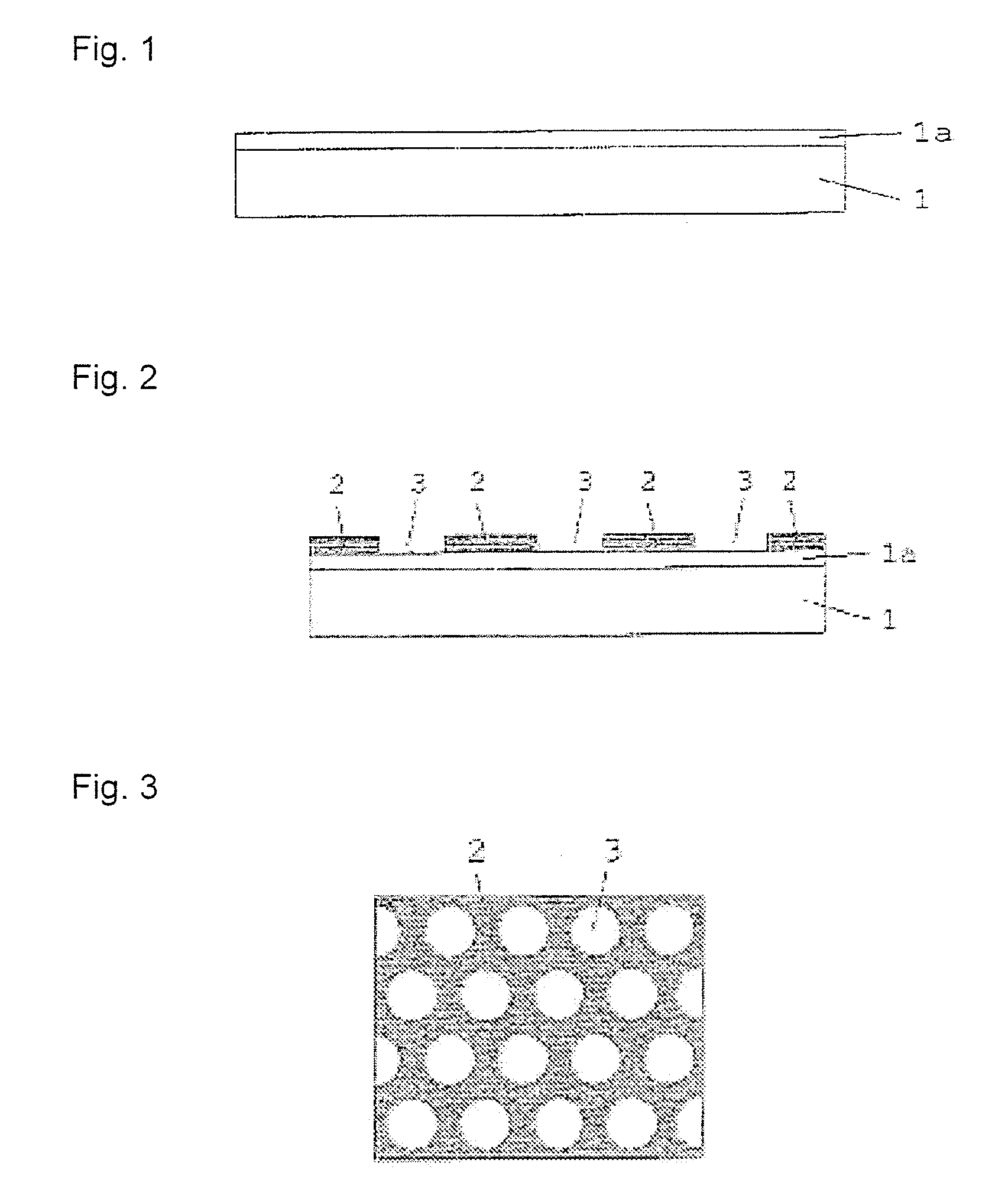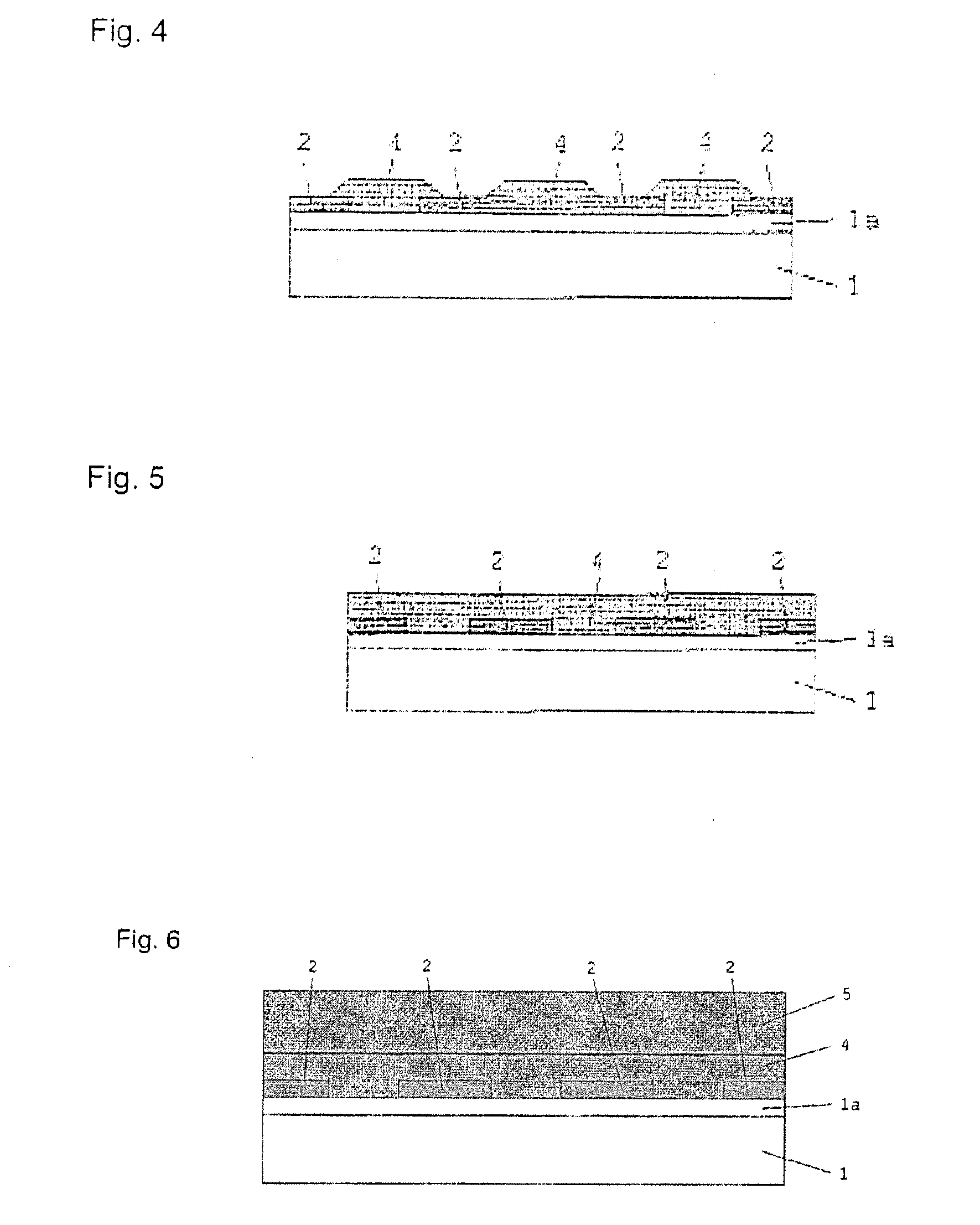Semi-conductor substrate and method of masking layer for producing a free-standing semi-conductor substrate by means of hydride-gas phase epitaxy
a technology of semi-conductor substrate and mask layer, which is applied in the direction of non-metal conductors, instruments, oxide conductors, etc., can solve the problems of subsequent processing, failure to manufacture gan crystals with diameters of 2 inches or more by conventional single crystal growth, and failure to grow by means of sublimation, etc., to achieve the effect of increasing the thickness of the layer
- Summary
- Abstract
- Description
- Claims
- Application Information
AI Technical Summary
Benefits of technology
Problems solved by technology
Method used
Image
Examples
first embodiment
[0049]In a first embodiment, a starting substrate 1 (c-plane sapphire wafer, 2 inch or 50.8 mm diameter) is subjected to be grown by a 2 μm thick initial layer 1a of GaN by means of MOVPE (FIG. 1). Subsequently, this initial layer 1a is covered on the whole area by a 100 nm thick, sputtered mask layer 2 (WSiN layer) (FIG. 2). This layer 2 is structured by means of lithography and subsequent etching process such that hexagonally disposed circular openings 3 (windows) are formed (FIG. 3). In the example, hexagonally disposed circular windows (openings 3) having 10 μm diameter and a distance between central points of adjacent windows of 15 μm are used.
[0050]On the thus structured starting substrate, firstly a first semiconductor layer 4 of GaN is then grown as a coalescence layer (FIG. 4 and FIG. 5). Here, the starting substrate 1 with the initial layer 1a, being structured with the mask layer 2 and the openings 3, is heated in a horizontal HVPE reactor up to 1,040° C., wherein the sur...
second embodiment
[0051]In a second embodiment, a starting substrate 1 (c-plane sapphire substrate, diameter 50.8 mm) is subjected to be overgrown with a 2 μm thick GaN initial layer 1a by means of MOVPE (FIG. 1). Subsequently, this initial layer is covered over the whole area by a 100 nm thick, sputtered mask layer 2 (WSiN-layer) (FIG. 2). This layer is structured by means of lithography and subsequent etching process such that parallel extending stripes (openings 3) are formed. It is therefore used as a stripe mask.
[0052]The thus structured starting wafer 1, 2 is then overgrown with GaN by means of MOVPE such that islands growing out of the windows coalesce (FIG. 4 / 5). After coalescence is completed, on the obtained coherent GaN layer 4, a layer 5 made of GaN, AlN or AlGaN having a thickness above 50 μm is grown with a process suitable for enabling high growth rates, wherein thicknesses above 200 μm are advantageous (FIG. 6). The stress occurring during growth between the starting substrate 1 and t...
third embodiment
[0053]In a third embodiment, a starting substrate 1 of SiC is used, and a prior deposition of an initial layer 1a is omitted. The SiC-wafer 1 is directly covered by the 100 nm thick, sputtered mask layer 2 (WSiN-layer). This layer 2 is structured by means of lithography and subsequent etching process such that hexagonally disposed, circular openings 3 (windows) are formed (FIG. 3).
[0054]The thus structured starting wafer 1, 2 is then overgrown with GaN by means of MOVPE such that islands growing out of the windows do coalesce. After coalescence is completed, a second semiconductor layer 5 of GaN, AlN or AlGaN having a thickness above 50 μm is grown on the obtained coherent GaN layer 4 by a process suitable for enabling high growth rates, wherein thicknesses above 200 μm are advantageous. The stress occurring during growth between the starting substrate 1 and the grown semiconductor substrate 6—consisting of the first semiconductor layer 4, the coalescence layer, and the thick, secon...
PUM
| Property | Measurement | Unit |
|---|---|---|
| thickness | aaaaa | aaaaa |
| thickness | aaaaa | aaaaa |
| diameters | aaaaa | aaaaa |
Abstract
Description
Claims
Application Information
 Login to View More
Login to View More - R&D
- Intellectual Property
- Life Sciences
- Materials
- Tech Scout
- Unparalleled Data Quality
- Higher Quality Content
- 60% Fewer Hallucinations
Browse by: Latest US Patents, China's latest patents, Technical Efficacy Thesaurus, Application Domain, Technology Topic, Popular Technical Reports.
© 2025 PatSnap. All rights reserved.Legal|Privacy policy|Modern Slavery Act Transparency Statement|Sitemap|About US| Contact US: help@patsnap.com



